 W
WThe Holy Grail is a treasure that serves as an important motif in Arthurian literature. Different traditions describe it as a cup, dish or stone with miraculous powers that provide happiness, eternal youth or sustenance in infinite abundance, often in the custody of the Fisher King. The term "holy grail" is often used to denote an elusive object or goal that is sought after for its great significance.
 W
WRichard William Barber FRSL FSA FRHistS is a British historian who has published several books about medieval history and literature. His book The Knight and Chivalry, about the interplay between history and literature, won the Somerset Maugham Award, a well-known British literary prize, in 1971. A similarly-themed 2004 book, The Holy Grail: Imagination and Belief, was widely praised in the UK press, and received major reviews in The New York Times and The New Republic.
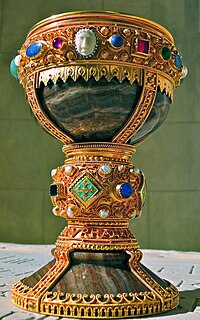 W
WThe Chalice of Doña Urraca is a jewel-encrusted onyx chalice kept at the Basilica of San Isidoro in León, Spain, which belonged to infanta Urraca of Zamora (1033-1101), daughter of Ferdinand I of Leon.
 W
WChrétien de Troyes was a French poet and trouvère known for his writing on Arthurian subjects, and for creating the characters of Lancelot, Percival and the Holy Grail. Chrétien's works, including Erec and Enide, Lancelot, Perceval and Yvain, represent some of the best-regarded of medieval literature. His use of structure, particularly in Yvain, has been seen as a step towards the modern novel.
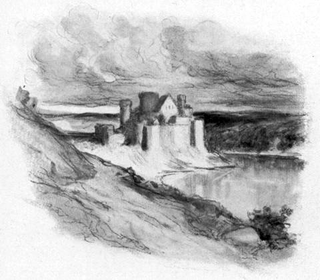 W
WCorbenic is the name of the Grail castle, the edifice housing the Holy Grail in Arthurian legend. It is a magical domain of the Grail keeper, often known as the Fisher King. The castle's descriptions vary greatly in different sources, and it first appears by that name in the Lancelot-Grail cycle where it is also the birthplace of Galahad.
 W
WDiu Crône is a Middle High German poem of about 30,000 lines treating of King Arthur and the Matter of Britain, dating from around the 1220s and attributed to the epic poet Heinrich von dem Türlin. Little is known of the author though it has been suggested that he was from the town of Sankt Veit an der Glan, then the residence of the Sponheim dukes of Carinthia.
 W
WIn Arthurian legend, the Fisher King, also known as the Wounded King or Maimed King, is the last in a long bloodline charged with keeping the Holy Grail. Versions of the original story vary widely, but he is always wounded in the legs or groin and incapable of standing. All he is able to do is fish in a small boat on the river near his castle, Corbenic, and wait for some noble who might be able to heal him by asking a certain question. In later versions, knights travel from many lands to try to heal the Fisher King, but only the chosen can accomplish the feat. This is achieved by Percival alone in the earlier stories; he is joined by Galahad and Bors in the later ones.
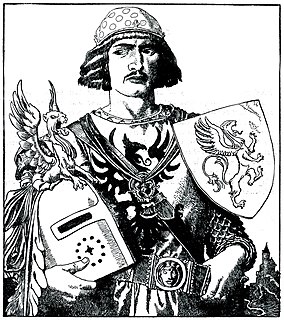 W
WGawain, also known as Gawaine or Gauwaine, among various other forms and spellings, is King Arthur's nephew and a Knight of the Round Table in the Arthurian legend. Under the name Gwalchmei, he is introduced very early in the legend's literature, being mentioned in some of the earliest Welsh Arthurian sources. As Gawain, he appears in Latin, French, English, Dutch, German, Spanish and Italian texts, notably as the protagonist of the story of Sir Gawain and the Green Knight. Other tales of Gawain include Historia Regum Britanniae, Roman de Brut, De Ortu Waluuanii, Diu Crône, The Awntyrs off Arthure, Ywain and Gawain, Golagros and Gawane, L'âtre périlleux, Le Chevalier à l'épée, and The Weddynge of Syr Gawen and Dame Ragnell, as well as the works of Chrétien de Troyes and the prose cycle Lancelot-Grail.
 W
WGlastonbury is a town and civil parish in Somerset, England, situated at a dry point on the low-lying Somerset Levels, 23 miles (37 km) south of Bristol. The town, which is in the Mendip district, had a population of 8,932 in the 2011 census. Glastonbury is less than 1 mile (2 km) across the River Brue from Street, which is now larger than Glastonbury.
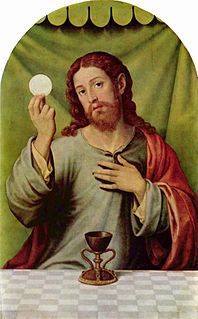 W
WThe Holy Chalice, also known as the Holy Grail, is in Christian tradition the vessel that Jesus used at the Last Supper to serve wine. The Synoptic Gospels refer to Jesus sharing a cup of wine with the Apostles, saying it was the covenant in his blood. The use of wine and chalice in the Eucharist in Christian churches is based on the Last Supper story. In the late 12th century, the author Robert de Boron associated the pre-existing story of the Holy Grail, a magical item from Arthurian literature, with the Holy Chalice. This association was continued in many subsequent Arthurian works, including the Lancelot-Grail (Vulgate) cycle, the Post-Vulgate Cycle, and Sir Thomas Malory's Le Morte d'Arthur. An ancient cup kept in the Spanish Cathedral of Valencia has been identified since Medieval times as the purported Holy Chalice used at the last supper.
 W
WJoseph of Arimathea was, according to all four canonical gospels, the man who assumed responsibility for the burial of Jesus after his crucifixion. The historical location of Arimathea is uncertain, although it has been identified with several towns. A number of stories that developed during the Middle Ages connect him with Glastonbury, England, and also with the Holy Grail legend.
 W
WEmma Jung was a Swiss Jungian analyst and author. She married Carl Jung, financing and helping him to become the prominent psychiatrist and founder of analytical psychology, and together they had five children. She was his "intellectual editor" to the end of her life. After her death, Jung described her as "a Queen".
 W
WLancelot du Lac, also written as Launcelot and other variants, is character in some versions of Arthurian legend, where he typically is depicted as King Arthur's close companion and one of the best Knights of the Round Table. In the French-inspired Arthurian chivalric romance tradition, Lancelot is the orphaned son of King Ban of the lost kingdom of Benwick, raised in the fairy realm by the Lady of the Lake. A hero of many battles, quests and tournaments, and famed as a nearly unrivaled swordsman and jouster, Lancelot becomes the lord of Joyous Gard and personal champion of Arthur's wife Queen Guinevere. But when his adulterous affair with Guinevere is discovered, it causes a civil war that is exploited by Mordred to end Arthur's kingdom.
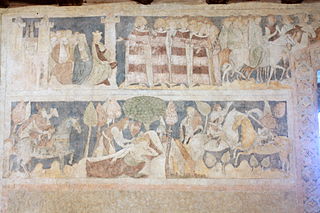 W
WThe Lancelot-Grail, also known as the Vulgate Cycle or the Pseudo-Map Cycle, is an early 13th-century Arthurian literary cycle consisting of interconnected prose episodes of chivalric romance in Old French. The cycle of unknown authorship, presenting itself as a chronicle of actual events, retells the legend of King Arthur by focusing on the love affair between Lancelot and Guinevere as well as the quest for the Holy Grail, expanding on the works of Robert de Boron and Chrétien de Troyes and influencing the Prose Tristan. After its completion around 1230–1235, the Lancelot–Grail was soon followed by its major rewrite known as the Post-Vulgate Cycle. Together, the two cycles constituted a highly influential and most widespread form of Arthurian romance literature during their time and also contributed the most to the later English compilation Le Morte d'Arthur that formed the basis for the legend's modern canon.
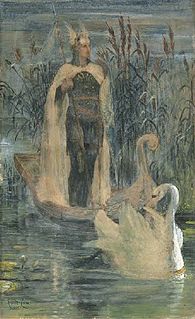 W
WLohengrin is a character in German Arthurian literature. The son of Parzival (Percival), he is a knight of the Holy Grail sent in a boat pulled by swans to rescue a maiden who can never ask his identity. His story, which first appears in Wolfram von Eschenbach's Parzival, is a version of the Knight of the Swan legend known from a variety of medieval sources. Wolfram's story was expanded in two later romances. Richard Wagner's opera Lohengrin of 1848 is based upon the legend.
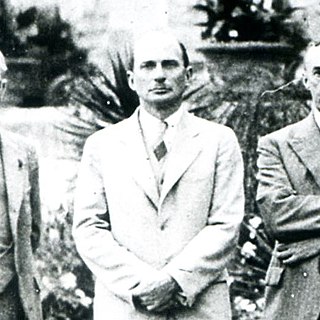 W
WRoger Sherman Loomis (1887–1966) was an American scholar and one of the foremost authorities on medieval and Arthurian literature. Loomis is perhaps best known for showing the roots of Arthurian legend, in particular the Holy Grail, in native Celtic mythology.
 W
WThe Matter of Britain is the body of Medieval literature and legendary material associated with Great Britain and Brittany, and the legendary kings and heroes associated with it, particularly King Arthur. It was one of the three great story cycles recalled repeatedly in medieval literature, together with the Matter of France, which concerned the legends of Charlemagne, and the Matter of Rome, which included material derived from or inspired by classical mythology.
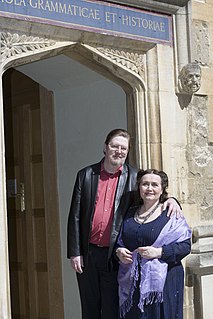 W
WJohn Matthews and Caitlín Matthews are English writers. Together, they have written over 150 books, translated into more than thirty languages, including Tarot packs, a card-based storytelling system, screenplays, songs and other works.
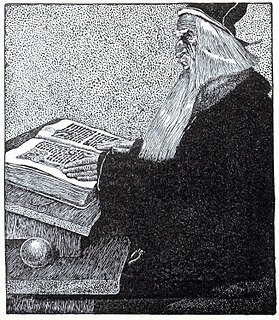 W
WMerlin is a mythological figure prominently featured in the legend of King Arthur and best known as an enchanter or wizard. His standard depiction, based on an amalgamation of historical and legendary figures, was introduced by the 12th-century British author Geoffrey of Monmouth. Geoffrey primarily combined existing stories of Myrddin Wyllt, a North Brythonic prophet and madman with no connection to Arthur, with tales of the Romano-British war leader Ambrosius Aurelianus to form the composite figure he called Merlinus Ambrosius . Geoffrey's rendering of the character was immediately popular, especially in Wales. Later writers in France and elsewhere expanded the account to produce a fuller image, creating one of the most important figures in the imagination and literature of the Middle Ages.
 W
WThe Lancelot-Grail, also known as the Vulgate Cycle or the Pseudo-Map Cycle, is an early 13th-century Arthurian literary cycle consisting of interconnected prose episodes of chivalric romance in Old French. The cycle of unknown authorship, presenting itself as a chronicle of actual events, retells the legend of King Arthur by focusing on the love affair between Lancelot and Guinevere as well as the quest for the Holy Grail, expanding on the works of Robert de Boron and Chrétien de Troyes and influencing the Prose Tristan. After its completion around 1230–1235, the Lancelot–Grail was soon followed by its major rewrite known as the Post-Vulgate Cycle. Together, the two cycles constituted a highly influential and most widespread form of Arthurian romance literature during their time and also contributed the most to the later English compilation Le Morte d'Arthur that formed the basis for the legend's modern canon.
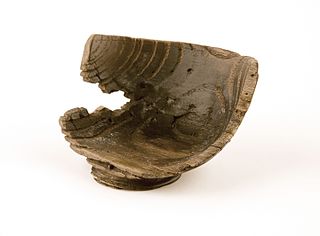 W
WThe Nanteos Cup is a medieval wood mazer bowl, held for many years at Nanteos Mansion, Rhydyfelin, near Aberystwyth in Wales.
 W
WParzival is a medieval romance by the knight-poet Wolfram von Eschenbach in Middle High German. The poem, commonly dated to the first quarter of the 13th century, centers on the Arthurian hero Parzival and his long quest for the Holy Grail following his initial failure to achieve it.
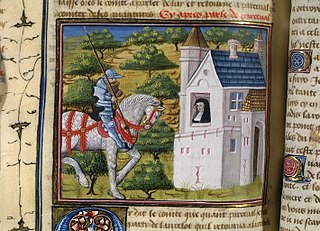 W
WPerceval, the Story of the Grail is the unfinished fifth verse romance by Chrétien de Troyes, written by him in Old French in the late 12th century. Later authors added 54,000 more lines in what are known collectively as the Four Continuations, as well as other related texts. Perceval is the earliest recorded account of what was to become the Quest for the Holy Grail but describes only a golden grail in the central scene, does not call it "holy" and treats a lance, appearing at the same time, as equally significant.
 W
WPercival —or Peredur, Perceval, Parzival, Parsifal, etc.—is one of King Arthur's legendary Knights of the Round Table. First made famous by the French author Chretien de Troyes in the tale Perceval, the Story of the Grail, he is best known for being the original hero in the quest for the Grail, before being replaced in later English and French literature by Galahad.
 W
WPeredur son of Efrawg is one of the Three Welsh Romances associated with the Mabinogion. It tells a story roughly analogous to Chrétien de Troyes' unfinished romance Perceval, the Story of the Grail, but it contains many striking differences from that work, most notably the absence of the French poem's central object, the grail.
 W
WThe Post-Vulgate Cycle, also known as the Post-Vulgate Arthuriad, the Post-Vulgate Roman du Graal or the Pseudo-Robert de Boron Cycle, is one of the major Old French prose cycles of Arthurian literature from the early 13th century. It is considered essentially a shortened rewriting of the earlier Vulgate Cycle, with much left out but also much added, including characters and scenes from the Prose Tristan.
 W
WThe Lancelot-Grail, also known as the Vulgate Cycle or the Pseudo-Map Cycle, is an early 13th-century Arthurian literary cycle consisting of interconnected prose episodes of chivalric romance in Old French. The cycle of unknown authorship, presenting itself as a chronicle of actual events, retells the legend of King Arthur by focusing on the love affair between Lancelot and Guinevere as well as the quest for the Holy Grail, expanding on the works of Robert de Boron and Chrétien de Troyes and influencing the Prose Tristan. After its completion around 1230–1235, the Lancelot–Grail was soon followed by its major rewrite known as the Post-Vulgate Cycle. Together, the two cycles constituted a highly influential and most widespread form of Arthurian romance literature during their time and also contributed the most to the later English compilation Le Morte d'Arthur that formed the basis for the legend's modern canon.
 W
WOtto Wilhelm Rahn was a German writer, medievalist, Ariosophist, and an officer of the SS and researcher into the Grail myths. He was born in Michelstadt, Germany, and died in Söll in Austria. Speculation still surrounds Otto Rahn and his research.
 W
WRigaut de Berbezilh was a troubadour of the petty nobility of Saintonge. He was a great influence on the Sicilian School and is quoted in the Roman de la Rose. About fifteen of his poems survive, including one planh and nine or ten cansos. His name is sometimes given as Richart or Richartz.
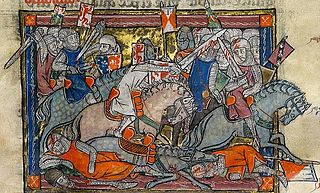 W
WThe Rochefoucauld Grail is a four-volume 14th-century illuminated manuscript. Three volumes were formerly Amsterdam, Bibliotheca Philosophica Hermetica, MS 1; the fourth volume is divided between the Bodleian Library in Oxford and the John Rylands Library in Manchester. It contains the Lancelot-Grail cycle in French prose, the oldest and most comprehensive surviving version of the legend of King Arthur and the Holy Grail. The leaves are about 405 mm by 295 mm, and are written in two columns, by a number of scribes.
 W
WThe Holy Chalice, also known as the Holy Grail, is in Christian tradition the vessel that Jesus used at the Last Supper to serve wine. The Synoptic Gospels refer to Jesus sharing a cup of wine with the Apostles, saying it was the covenant in his blood. The use of wine and chalice in the Eucharist in Christian churches is based on the Last Supper story. In the late 12th century, the author Robert de Boron associated the pre-existing story of the Holy Grail, a magical item from Arthurian literature, with the Holy Chalice. This association was continued in many subsequent Arthurian works, including the Lancelot-Grail (Vulgate) cycle, the Post-Vulgate Cycle, and Sir Thomas Malory's Le Morte d'Arthur. An ancient cup kept in the Spanish Cathedral of Valencia has been identified since Medieval times as the purported Holy Chalice used at the last supper.
 W
WThe Waste Land is a poem by T. S. Eliot, widely regarded as one of the most important poems of the 20th century and a central work of modernist poetry. Published in 1922, the 434-line poem first appeared in the United Kingdom in the October issue of Eliot's The Criterion and in the United States in the November issue of The Dial. It was published in book form in December 1922. Among its famous phrases are "April is the cruellest month", "I will show you fear in a handful of dust", and the mantra in the Sanskrit language "Shantih shantih shantih".
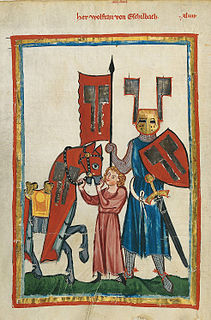 W
WWolfram von Eschenbach was a German knight, poet and composer, regarded as one of the greatest epic poets of medieval German literature. As a Minnesinger, he also wrote lyric poetry.
 W
W